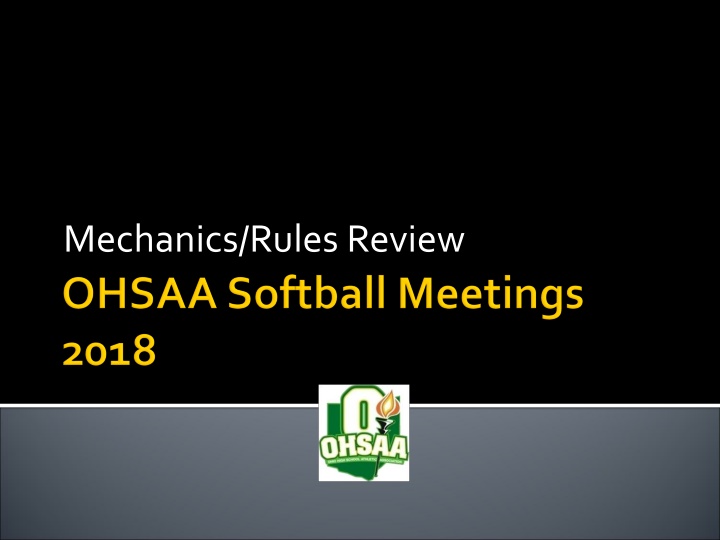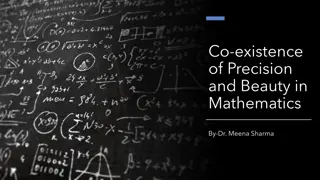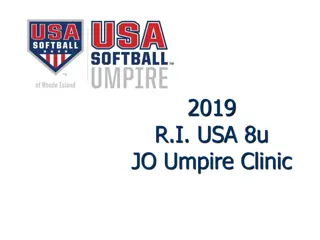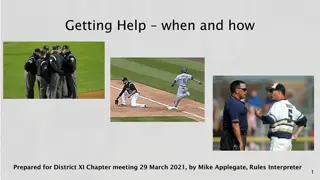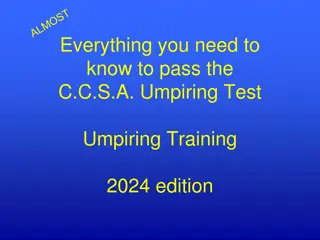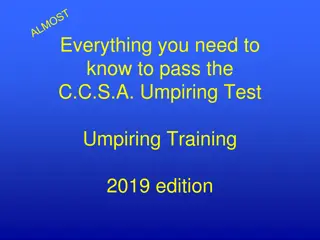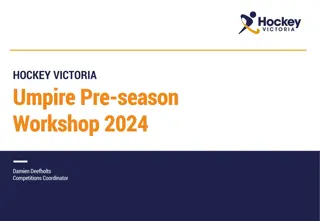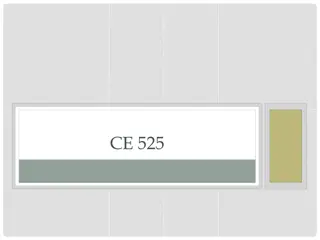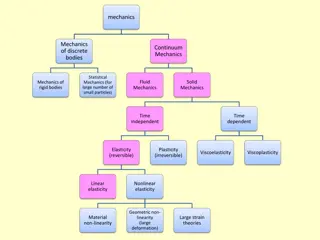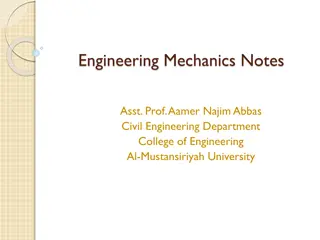Enhancing Umpiring Mechanics for Precision and Clarity
Improve umpiring standards by adhering to NFHS mechanics, focusing on position, angles, and communication, and incorporating feedback for consistent and effective officiating. Emphasize stationary play observation, proper positioning, and decision-making to ensure accurate calls and promote professional growth.
Download Presentation

Please find below an Image/Link to download the presentation.
The content on the website is provided AS IS for your information and personal use only. It may not be sold, licensed, or shared on other websites without obtaining consent from the author.If you encounter any issues during the download, it is possible that the publisher has removed the file from their server.
You are allowed to download the files provided on this website for personal or commercial use, subject to the condition that they are used lawfully. All files are the property of their respective owners.
The content on the website is provided AS IS for your information and personal use only. It may not be sold, licensed, or shared on other websites without obtaining consent from the author.
E N D
Presentation Transcript
Use of NFHS Standard Mechanics Solid, Sound Reasoning Easy to understand Many Areas/Associations did their own thing Countless deviations Need for uniformity & consistency statewide Put umpires in the best place for call Improve communication Preplanned deviations are unacceptable Goal is to get plays right and communicate
Position Angle, Distance, Unobstructed View are the keys Stationary Stop/Set/See Play/Make Call Timing These must be worked on every game, all season long as well as in preseason training With more training being offered we have a higher level of expectation for our umpires
Based on feedback from many sources Tournament Observers Interpreters, secretaries and other local association officers Questions from umpires
Position, Slot, Stance, Head Level When to get set Set, Lock In, Track Ball, No Leaning, Stay Down Voice on Balls/Strikes Proper Signals Timing Sell the K Swinging K
Remove Mask Unnecessary Foul Calls Trail the B/R Fair/Foul Positioning and Mechanics Straddle Line and Priorities Use of Holding Zone Proper Position Plays at 3B and Plate Movement on Foul Flies When partner out cover bases and don t echo partner
Base Umpires Too Deep Square up to plate Watch pitcher See Pitcher, Plate, Runner(s) Observe/Call Illegal Pitch Walk the line Lock In and Set elsewhere Ready Position Review Positions Lead Runner is key
Stop/Set/See/Call Stationary/Timing Distance/Angle/Unobstructed View Force Plays vs. Tag Plays Leading Edge Plays at 1B Position/Angle/Distance Inside/Outside Coverage Elements in front Tighten Buttonhooks Parallel Movement Outfield Coverage When/Routing/Get Set
Dress/Appearance Hats, Equipment, Wrist Watches, Two Ball Bags, Clean & Neat, Fitness Look the part on and off the field Keep Game Moving Ball Rotation Huddles and Charged Conferences Time Between Innings -Umpire Conferences Reduce Time Outs Wrist Band/Play Cards/Delays (6-2-3 & 7-3-1)
Record Subs, CRs, Conferences Dusting Bases and Pitcher s Plate Indicator Glance Signals Clear and Concise Sell Calls Illegal Pitches, Interference, Obstruction Infield Fly Signal Who Calls? Watch the Ball, Always Eyes on the Ball Returning to Position
Personnel out of dugout Pre-Pitch Planning Communication w/ Partner No Pre Planned Deviations Protect your partner Getting Help Leaving Field and Post Game
Substitution and Lineup Rules DP/Flex, Courtesy Runner, Re-entry, Short Handed, Recording Obstruction Definition and Penalty Interference -Definition and Penalty Equipment Illegal Pitch Safety Rules Baseball/Softball Rules Differences
